
The Comprehensive Guide to UI/UX Designer Job Descriptions: Roles, Skills, and Industry Insights
Oct 13, 2025 6 Min Read 6974 Views
(Last Updated)
The importance of user interface (UI) and user experience (UX) design cannot be overstated. As businesses strive to create intuitive, engaging, and efficient digital products, the demand for skilled UI/UX designers continues to grow. In this comprehensive guide, we will explore the role of a UI/UX designer, exploring the job description, required skills, and industry trends that shape this dynamic profession.
Whether you’re an aspiring designer, a hiring manager, or simply curious about the field, this blog post will provide valuable insights into the world of UI/UX design. We’ll cover everything from core responsibilities and essential skills to education requirements, tools of the trade, and future prospects in this ever-evolving field.
Table of contents
- What is UI/UX Design?
- Key Responsibilities of a UI/UX Designer
- UI/UX Designer Roles
- Essential Skills for UI/UX Designers
- Tools and Software Proficiency
- Education and Experience Requirements
- Education
- Experience
- Industry Trends and Future Outlook in UI/UX Design
- Career Growth
- Common Challenges in UI/UX Design Roles
- Tips for Aspiring UI/UX Designers
- Conclusion
- FAQs
- What are the primary roles and responsibilities of a UI/UX designer?
- What key skills are required for a UI/UX designer?
- How does the role of a UI designer differ from that of a UX designer?
- What industry trends are currently shaping the field of UI/UX design?
- What qualifications or education are typically required for a career in UI/UX design?
What is UI/UX Design?

Before getting into the job description, it’s crucial to understand what UI/UX design entails. While often used interchangeably, UI (User Interface) and UX (User Experience) are distinct yet complementary aspects of design.
User Interface (UI) Design focuses on the visual elements of digital products. It encompasses the look and feel, presentation, and interactivity of a product. UI designers are responsible for creating aesthetically pleasing, responsive, and intuitive interfaces that users interact with directly.
User Experience (UX) Design, on the other hand, is a broader discipline that considers the entire journey of user interaction with a product or service. UX designers focus on understanding user behaviors, needs, and motivations to create seamless, efficient, and enjoyable experiences across all touchpoints.
In practice, many roles combine both UI and UX responsibilities, leading to the hybrid UI/UX designer position. These professionals are tasked with creating visually appealing interfaces that also deliver optimal user experiences.
Key Responsibilities of a UI/UX Designer

A UI/UX designer’s job description typically includes a wide range of responsibilities that span the entire UI/UX design process. Here are some core duties:
- User Research: Conducting interviews, surveys, and usability tests to understand user needs, behaviors, and pain points.
- Information Architecture: Organizing and structuring content to ensure logical and intuitive navigation within the product.
- Wireframing and Prototyping: Creating low-fidelity sketches and interactive prototypes to visualize design concepts and user flows.
- Visual Design: Developing the aesthetic elements of interfaces, including color schemes, typography, icons, and overall visual style.
- Interaction Design: Designing how users interact with the interface, including animations, transitions, and responsive behaviors.
- Usability Testing: Planning and conducting tests to evaluate the effectiveness and efficiency of designs.
- Collaboration: Working closely with cross-functional teams, including product managers, developers, and stakeholders.
- Design System Management: Creating and maintaining a cohesive design system to ensure consistency across products.
- Accessibility Considerations: Ensuring designs are inclusive and accessible to users with diverse abilities.
- Iterative Design: Continuously refining designs based on user feedback and data-driven insights.
If you want to explore more about it, join HCL GUVI’s UI/UX Course with Placement Assistance. You’ll also learn about the tools used in UI/UX which are AdobeXD, Illustrator, Photoshop, Figma, and many more. Build some amazing real-time projects to get hands-on experience.
UI/UX Designer Roles
UI/UX design is crucial in creating engaging and effective user experiences. Each role within this field offers unique opportunities for growth. Here’s an overview of key roles within UI/UX design:
| Role | Responsibilities | Skills Needed | Average Salary |
| UI Designer | – Designing user interfaces for websites and applications. – Creating visually appealing and intuitive layouts. – Ensuring consistency in visual elements across platforms. – Collaborating with developers to implement designs accurately. | – Proficiency in design tools (e.g., Sketch, Figma, Adobe XD). – Strong understanding of visual design principles. – Attention to detail and a keen eye for aesthetics. | ₹4,00,000 – ₹8,00,000/year |
| UX Designer | – Conducting user research to understand user needs and behaviors. – Creating user personas and user journey maps. – Designing wireframes, prototypes, and user flows. – Conducting usability testing and iterating designs based on feedback. | – Expertise in user research methods and usability testing. – Proficiency in wireframing and prototyping tools. – Strong analytical and problem-solving skills. | ₹5,00,000 – ₹12,00,000/year |
| Product Designer | – Overseeing the entire design process from concept to final implementation. – Collaborating with product managers and developers to align design with product goals. – Iterating on designs based on user feedback and testing results. – Ensuring a cohesive and seamless user experience across products. | – Broad skill set in both UI and UX design. – Strong project management and communication skills. – Ability to balance user needs with business objectives. | ₹7,00,000 – ₹15,00,000/year |
| Interaction Designer | – Designing interactive elements and animations to enhance user experience. – Creating and testing interactive prototypes. – Defining and implementing interaction patterns and behaviors. – Collaborating with developers to ensure smooth implementation of interactions. | – Proficiency in interaction design tools and animation software. – Strong understanding of interaction principles and user behavior. – Creativity and attention to detail in designing interactive experiences. | ₹5,00,000 – ₹10,00,000/year |
| Visual Designer | – Focusing on the visual aesthetics of digital products. – Creating high-fidelity designs and visual assets. – Ensuring brand consistency and visual identity across all digital touchpoints. – Collaborating with UI/UX designers to refine visual design elements. | – Expertise in visual design tools (e.g., Adobe Creative Suite). – Strong sense of typography, color theory, and layout. – Experience with brand design and identity. | ₹4,00,000 – ₹9,00,000/year |
| UX Researcher | – Conducting in-depth research to gather insights into user needs and behaviors. – Performing qualitative and quantitative research methods (e.g., interviews, surveys, usability tests). – Analyzing research data to inform design decisions. – Presenting findings and recommendations to stakeholders. | – Expertise in research methodologies and data analysis. – Strong analytical and critical thinking skills. – Ability to communicate research findings effectively. | ₹6,00,000 – ₹14,00,000/year |
| UI/UX Architect | – Designing the overall structure and navigation of digital products. – Ensuring a logical flow of content and functionality. – Collaborating with UI/UX designers and developers to create a coherent user experience. – Defining and maintaining design systems and patterns. | – Proficiency in information architecture and design systems. – Strong understanding of user flow and navigation design. – Experience with creating and maintaining design documentation. | ₹10,00,000 – ₹18,00,000/year |
| Design Systems Manager | – Creating and managing design systems and component libraries. – Ensuring consistency and efficiency in design processes. – Collaborating with UI/UX teams to implement and maintain design standards. – Conducting audits and updates to keep design systems current. | – Expertise in design systems and component-based design. – Strong organizational and management skills. – Ability to communicate and collaborate across teams. | ₹8,00,000 – ₹16,00,000/year |
Essential Skills for UI/UX Designers

To excel in this role, UI/UX designers need a diverse skill set that combines creativity, technical proficiency, and analytical thinking. Here are the essential skills often listed in job descriptions:
- Visual Design Skills: Proficiency in creating visually appealing and functional designs, including a strong understanding of color theory, typography, and layout principles.
- User-Centered Design Thinking: The ability to approach design challenges from the user’s perspective and create solutions that address real needs.
- Wireframing and Prototyping: Skill in creating low-fidelity wireframes and high-fidelity prototypes to communicate design ideas effectively.
- User Research and Analysis: Competence in conducting user research, analyzing data, and translating insights into design decisions.
- Information Architecture: The ability to organize and structure information in a logical and user-friendly manner.
- Interaction Design: Understanding how to create intuitive and engaging user interactions within digital interfaces.
- Adaptability and Problem-Solving: The capacity to tackle complex design challenges and adapt to changing project requirements.
- Communication Skills: Strong verbal and written communication abilities to articulate design decisions and collaborate effectively with team members and stakeholders.
- Attention to Detail: A meticulous approach to design, ensuring consistency and quality across all elements of the user interface.
- Time Management: The ability to manage multiple projects and prioritize tasks effectively in a fast-paced environment.
Tools and Software Proficiency
UI/UX designers are expected to be proficient in a variety of design and prototyping tools. Common software requirements include:
- Design Tools
- Adobe Creative Suite (Photoshop, Illustrator, XD)
- Sketch
- Figma
- InVision Studio
- Prototyping Tools
- InVision
- Axure RP
- Adobe XD
- Principle
- User Research and Testing Tools
- UserTesting
- Hotjar
- Optimizely
- Google Analytics
- Basic Coding Knowledge
- HTML/CSS
- JavaScript (beneficial but not always required)
Proficiency in these UI/UX design tools enables designers to create, prototype, and collaborate efficiently throughout the design process.
Education and Experience Requirements
While specific requirements can vary depending on the company and position, most UI/UX designer job descriptions include the following education and experience criteria:
Education
- Bachelor’s degree in Design, Human-Computer Interaction, Computer Science, or a related field
- Some positions may accept equivalent practical experience in lieu of a degree
- Advanced degrees (e.g., Master’s in Interaction Design) can be advantageous for senior roles
Experience
- Typically, 2-5 years of professional experience for mid-level positions
- 5+ years for senior or lead designer roles
- A strong portfolio showcasing diverse projects and problem-solving skills
Many job descriptions also emphasize the importance of continuous learning and staying updated with the latest design trends and technologies.
Industry Trends and Future Outlook in UI/UX Design
UI/UX design is a rapidly evolving field, and job descriptions often reflect current industry trends. Some key areas of focus include:
- Mobile Usage: As of 2024, over 60% of global web traffic comes from mobile devices. [Source: Statista]
- AI Integration: 54% of businesses are already using AI to enhance UX through personalized content, chatbots, and predictive analytics. [Source: Adobe]
- Voice Interfaces: The use of voice interfaces is growing rapidly, with an estimated 8.4 billion voice assistants in use worldwide by 2024. [Source: Statista]
Staying informed about these trends and demonstrating adaptability is crucial for UI/UX designers to remain competitive in the job market.
Career Growth
Career growth opportunities in UI/UX design are abundant, with potential paths including:
- Specialization in areas like interaction design, information architecture, or user research
- Advancement to senior UI/UX designer or design lead positions
- Transition into UX strategy or product management roles
- Entrepreneurship and consulting opportunities
Many job descriptions highlight potential for growth within the organization, emphasizing the value placed on UI/UX expertise in today’s digital landscape.
Common Challenges in UI/UX Design Roles

Understanding the challenges faced by UI/UX designers can help both job seekers and employers set realistic expectations. Some common challenges include:
- Balancing User Needs with Business Goals: Finding solutions that satisfy both user requirements and company objectives.
- Keeping Up with Rapid Technological Changes: Continuously learning new tools and adapting to emerging technologies.
- Communicating Design Decisions: Effectively explaining and justifying design choices to non-design stakeholders.
- Managing Tight Deadlines: Delivering high-quality work under time constraints and shifting priorities.
- Gathering Meaningful User Insights: Conducting effective research with limited resources or access to users.
- Designing for Diverse User Groups: Creating inclusive experiences that cater to users with varying abilities and backgrounds.
- Measuring Design Impact: Quantifying the success of design interventions and demonstrating ROI.
- Navigating Organizational Politics: Advocating for user-centered design within organizations that may have conflicting priorities.
Addressing these challenges in job descriptions can help set realistic expectations and attract candidates who are prepared to tackle these issues.
Tips for Aspiring UI/UX Designers
For those looking to enter or advance in the field of UI/UX design, consider the following tips:
- Build a Strong Portfolio: Showcase your best work, focusing on the problem-solving process as well as the final designs.
- Develop a Broad Skill Set: Cultivate skills across various aspects of UI/UX, from research to visual design.
- Stay Updated: Follow industry leaders, attend conferences, and participate in online courses to keep your skills current.
- Network: Join design communities, attend meetups, and engage with other professionals in the field.
- Practice Real-World Problem Solving: Work on personal projects or contribute to open-source initiatives to gain practical experience.
- Seek Mentorship: Connect with experienced designers who can provide guidance and industry insights.
- Develop Soft Skills: Focus on improving communication, presentation, and collaboration abilities.
- Understand Business and Technology: Gain knowledge of business strategies and technical constraints to create more effective designs.
- Embrace Feedback: Be open to constructive criticism and use it to improve your work continuously.
- Be User-Centric: Always prioritize the user’s needs and experiences in your design approach.
If you want to explore Figma through a self-paced course, try HCL GUVI’s Figma certification course.
Conclusion
Remember that the field of UI/UX design is constantly evolving, driven by technological advancements and changing user expectations. The most successful designers are those who remain curious, adaptable, and committed to lifelong learning.
As you craft job descriptions or prepare for a career in UI/UX design, focus on the intersection of creativity, technical skill, and user empathy. By doing so, you’ll be well-positioned to contribute to the creation of digital products that not only look great but also provide meaningful and valuable experiences to users around the world.
FAQs
What are the primary roles and responsibilities of a UI/UX designer?
UI/UX designers are responsible for creating intuitive and aesthetically pleasing interfaces for websites and applications. Their roles typically include user research, wireframing, prototyping, designing user interfaces, and conducting usability testing. They ensure that the end product meets user needs and provides a seamless user experience.
What key skills are required for a UI/UX designer?
Essential skills for UI/UX designers include proficiency in design tools (such as Adobe XD, Sketch, Figma), understanding of user research methods, wireframing and prototyping, knowledge of usability principles, and strong problem-solving abilities. Good communication and collaboration skills are also crucial for working with cross-functional teams.
How does the role of a UI designer differ from that of a UX designer?
UI designers focus on the look and feel of a product, including layout, color schemes, and typography. They work on the visual aspects to ensure that the interface is attractive and user-friendly. UX designers, on the other hand, focus on the overall user experience, including user research, wireframing, and testing to ensure that the product meets user needs and provides a smooth, intuitive experience.
What industry trends are currently shaping the field of UI/UX design?
Current trends in UI/UX design include the increasing use of AI and machine learning to personalize user experiences, the rise of mobile-first design, the emphasis on accessibility and inclusive design, and the growing importance of data-driven design decisions. Keeping up with these trends is essential for staying relevant in the field.
What qualifications or education are typically required for a career in UI/UX design?
While some UI/UX designers have formal degrees in design, computer science, or related fields, others may have gained skills through bootcamps, online courses, or self-study. A strong portfolio showcasing relevant projects and practical experience often plays a critical role in securing a job in UI/UX design.























Did you enjoy this article?